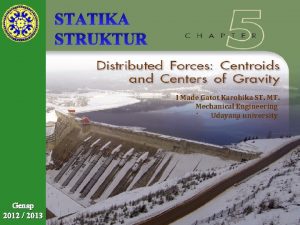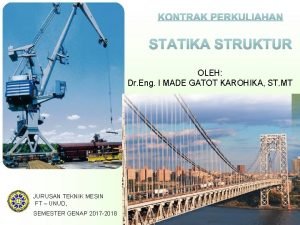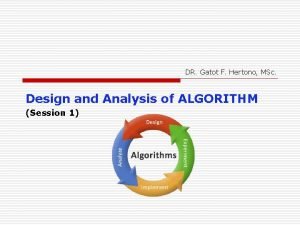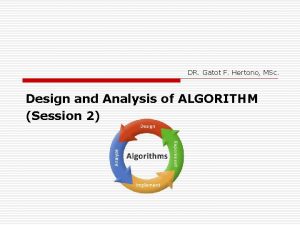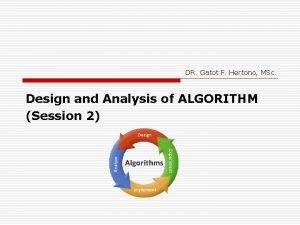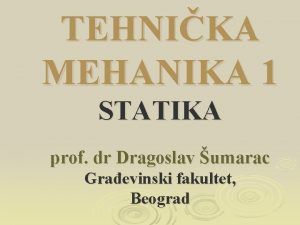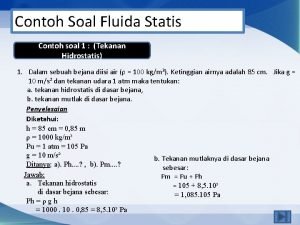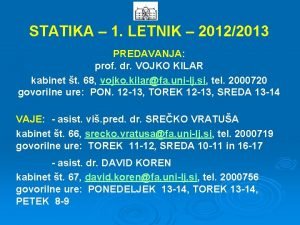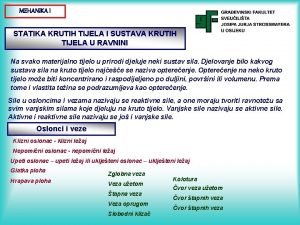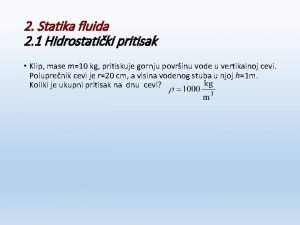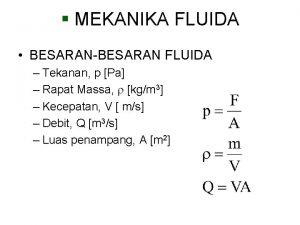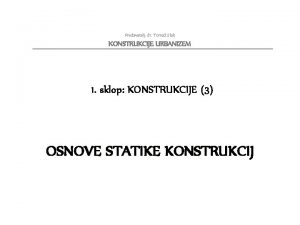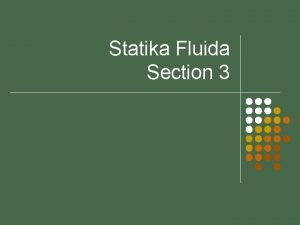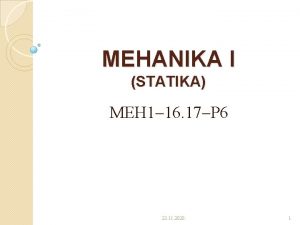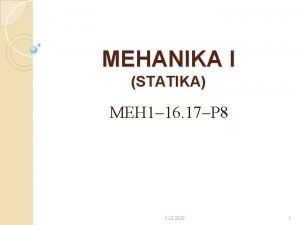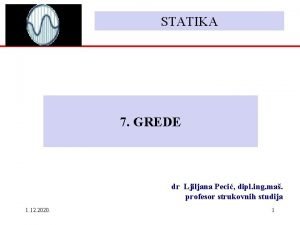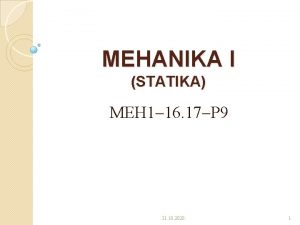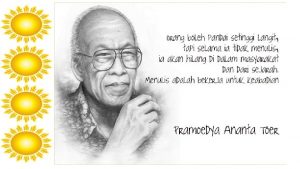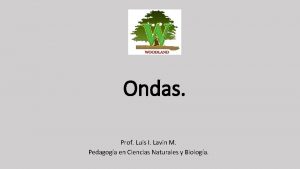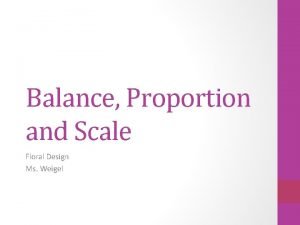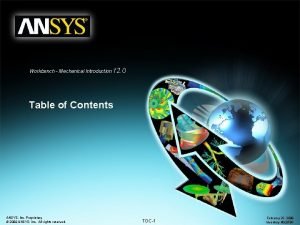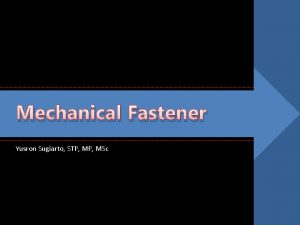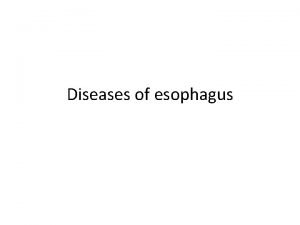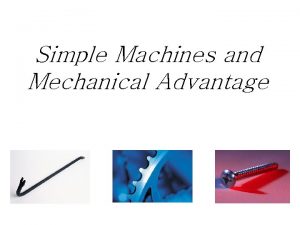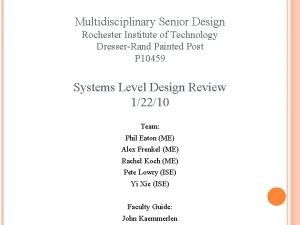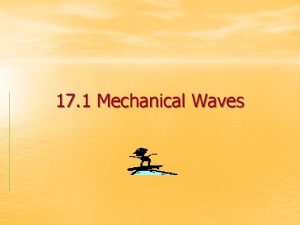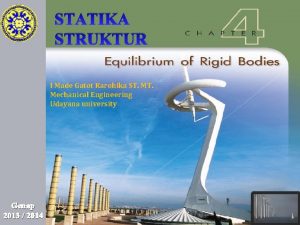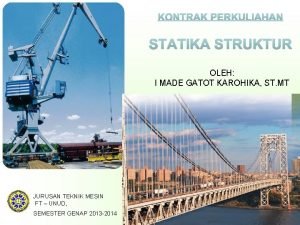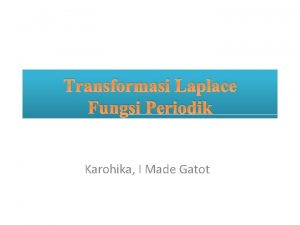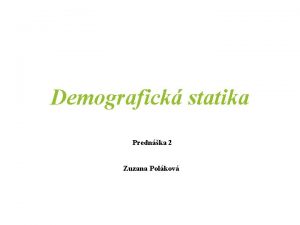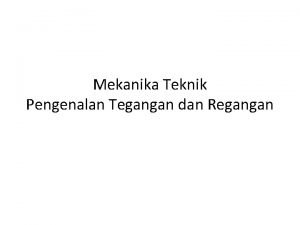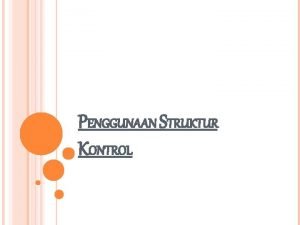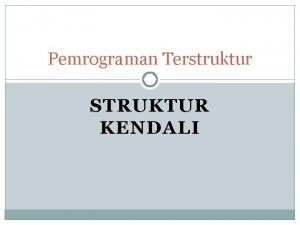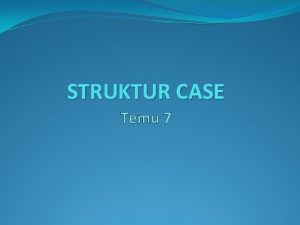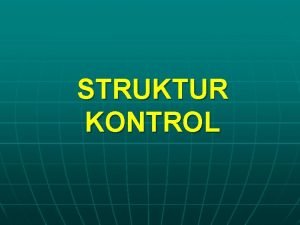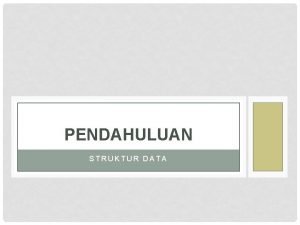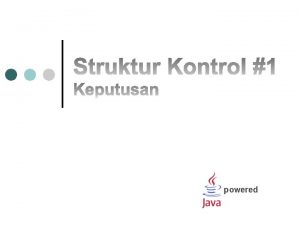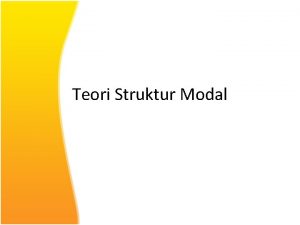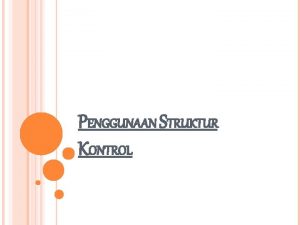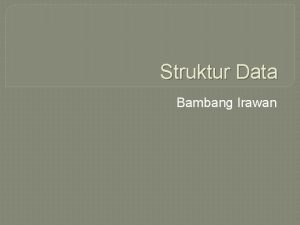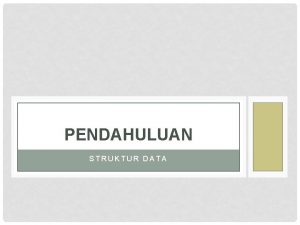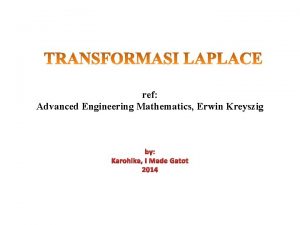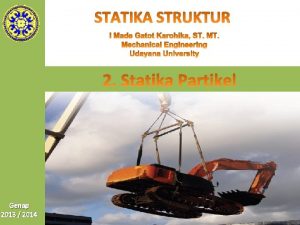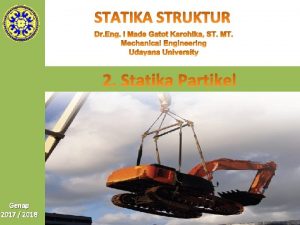STATIKA STRUKTUR I Made Gatot Karohika ST Mechanical
































- Slides: 32

STATIKA STRUKTUR I Made Gatot Karohika ST. Mechanical Engineering Udayana university Genap 2012 / 2013

Contents Introduction Theorems of Pappus-Guldinus Center of Gravity of a 2 D Body Sample Problem 5. 7 Centroids and First Moments of Areas and Lines Distributed Loads on Beams Centroids of Common Shapes of Areas Centroids of Common Shapes of Lines Center of Gravity of a 3 D Body: Centroid of a Volume Composite Plates and Areas Centroids of Common 3 D Shapes Sample Problem 5. 1 Composite 3 D Bodies Determination of Centroids by Integration Sample Problem 5. 12 Sample Problem 5. 9 Sample Problem 5. 4 5 -2

Introduction • The earth exerts a gravitational force on each of the particles forming a body. These forces can be replace by a single equivalent force equal to the weight of the body and applied at the center of gravity for the body. • The centroid of an area is analogous to the center of gravity of a body. The concept of the first moment of an area is used to locate the centroid. • Determination of the area of a surface of revolution and the volume of a body of revolution are accomplished with the Theorems of Pappus-Guldinus. 5 -3

Center of Gravity of a 2 D Body • Center of gravity of a plate • Center of gravity of a wire 5 -4

Centroids and First Moments of Areas and Lines • Centroid of an area • Centroid of a line 5 -5

First Moments of Areas and Lines • An area is symmetric with respect to an axis BB’ if for every point P there exists a point P’ such that PP’ is perpendicular to BB’ and is divided into two equal parts by BB’. • The first moment of an area with respect to a line of symmetry is zero. • If an area possesses a line of symmetry, its centroid lies on that axis • If an area possesses two lines of symmetry, its centroid lies at their intersection. • An area is symmetric with respect to a center O if for every element d. A at (x, y) there exists an area d. A’ of equal area at (-x, -y). • The centroid of the area coincides with the center of symmetry. 5 -6

Centroids of Common Shapes of Areas 5 -7

Centroids of Common Shapes of Lines 5 -8

Composite Plates and Areas • Composite plates • Composite area 5 -9

Sample Problem 5. 1 SOLUTION: • Divide the area into a triangle, rectangle, and semicircle with a circular cutout. • Calculate the first moments of each area with respect to the axes. For the plane area shown, determine the first moments with respect to the x and y axes and the location of the centroid. • Find the total area and first moments of the triangle, rectangle, and semicircle. Subtract the area and first moment of the circular cutout. • Compute the coordinates of the area centroid by dividing the first moments by the total area. 5 - 10

Sample Problem 5. 1 • Find the total area and first moments of the triangle, rectangle, and semicircle. Subtract the area and first moment of the circular cutout. 5 - 11

Sample Problem 5. 1 • Compute the coordinates of the area centroid by dividing the first moments by the total area. 5 - 12

Determination of Centroids by Integration • Double integration to find the first moment may be avoided by defining d. A as a thin rectangle or strip. 5 - 13

Sample Problem 5. 4 SOLUTION: • Determine the constant k. • Evaluate the total area. Determine by direct integration the location of the centroid of a parabolic spandrel. • Using either vertical or horizontal strips, perform a single integration to find the first moments. • Evaluate the centroid coordinates. 5 - 14

Sample Problem 5. 4 SOLUTION: • Determine the constant k. • Evaluate the total area. 5 - 15

Sample Problem 5. 4 • Using vertical strips, perform a single integration to find the first moments. 5 - 16

Sample Problem 5. 4 • Or, using horizontal strips, perform a single integration to find the first moments. 5 - 17

Sample Problem 5. 4 • Evaluate the centroid coordinates. 5 - 18

Theorems of Pappus-Guldinus • Surface of revolution is generated by rotating a plane curve about a fixed axis. • Area of a surface of revolution is equal to the length of the generating curve times the distance traveled by the centroid through the rotation. 5 - 19

Theorems of Pappus-Guldinus • Body of revolution is generated by rotating a plane area about a fixed axis. • Volume of a body of revolution is equal to the generating area times the distance traveled by the centroid through the rotation. 5 - 20

Sample Problem 5. 7 SOLUTION: • Apply theorem of Pappus-Guldinus to evaluate the volumes or revolution for the rectangular rim section and the inner cutout section. • Multiply by density and acceleration to get the mass and acceleration. The outside diameter of a pulley is 0. 8 m, and the cross section of its rim is as shown. Knowing that the pulley is made of steel and that the density of steel is determine the mass and weight of the rim. 5 - 21

Sample Problem 5. 7 SOLUTION: • Apply theorem of Pappus-Guldinus to evaluate the volumes or revolution for the rectangular rim section and the inner cutout section. • Multiply by density and acceleration to get the mass and acceleration. 5 - 22

Distributed Loads on Beams • A distributed load is represented by plotting the load per unit length, w (N/m). The total load is equal to the area under the load curve. • A distributed load can be replace by a concentrated load with a magnitude equal to the area under the load curve and a line of action passing through the area centroid. 5 - 23

Sample Problem 5. 9 SOLUTION: • The magnitude of the concentrated load is equal to the total load or the area under the curve. • The line of action of the concentrated load passes through the centroid of the area under the curve. • Determine the support reactions by A beam supports a distributed load as summing moments about the beam shown. Determine the equivalent ends. concentrated load and the reactions at the supports. 5 - 24

Sample Problem 5. 9 SOLUTION: • The magnitude of the concentrated load is equal to the total load or the area under the curve. • The line of action of the concentrated load passes through the centroid of the area under the curve. 5 - 25

Sample Problem 5. 9 • Determine the support reactions by summing moments about the beam ends. 5 - 26

Center of Gravity of a 3 D Body: Centroid of a Volume • Center of gravity G • Results are independent of body orientation, • For homogeneous bodies, 5 - 27

Centroids of Common 3 D Shapes 5 - 28

Composite 3 D Bodies • Moment of the total weight concentrated at the center of gravity G is equal to the sum of the moments of the weights of the component parts. • For homogeneous bodies, 5 - 29

Sample Problem 5. 12 SOLUTION: • Form the machine element from a rectangular parallelepiped and a quarter cylinder and then subtracting two 1 -in. diameter cylinders. Locate the center of gravity of the steel machine element. The diameter of each hole is 1 in. 5 - 30

Sample Problem 5. 12 5 - 31

Sample Problem 5. 12 5 - 32
 Guldinus
Guldinus Karohika
Karohika Gatot f hertono
Gatot f hertono Dr gatot
Dr gatot Gatot f hertono
Gatot f hertono Kako se deli mehanika
Kako se deli mehanika Latihan soal fluida statis
Latihan soal fluida statis Statika 1
Statika 1 Konzola statika
Konzola statika Vodeni stub pritisak
Vodeni stub pritisak Statika
Statika Konzola statika
Konzola statika Statika fluida
Statika fluida Statika fluida
Statika fluida Pokretni i nepokretni oslonac
Pokretni i nepokretni oslonac Staticki dijagrami mehanika
Staticki dijagrami mehanika Kontinualna greda
Kontinualna greda Tanja kalman šipoš
Tanja kalman šipoš Statika 1
Statika 1 Konzola statika
Konzola statika Actual mechanical advantage vs ideal mechanical advantage
Actual mechanical advantage vs ideal mechanical advantage Struktur fisik pusi
Struktur fisik pusi Que es una onda mecanica
Que es una onda mecanica Type of pully
Type of pully Balance definition in floral design
Balance definition in floral design Workbench mechanical
Workbench mechanical Kekuatan baut fisher
Kekuatan baut fisher Sana altaf
Sana altaf Mechanical obstruction of esophagus
Mechanical obstruction of esophagus Asbetose
Asbetose How to calculate mechanical advantage
How to calculate mechanical advantage Pallets wiki
Pallets wiki What do mechanical waves require
What do mechanical waves require
